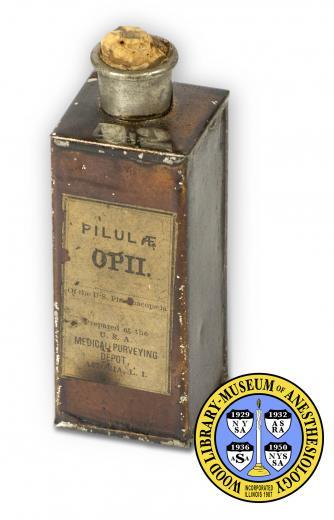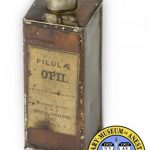Opium Tin
This opium tin was once a part of the U.S. Army Surgeon’s Field Companion. Also called the Coolidge Carrier Set, it was a kit issued to Union surgeons during the American Civil War (1861-1865). Designed by Medical Inspector R. H. Coolidge in 1863 to take the place of a heavier, more cumbersome knapsack, the kit was compact and included, among other supplies, ipecac, ginger, chloroform, quinine, whisky, bandages, needles and sutures.
Opium was used by both the Union and Confederate forces during the American Civil War. Most drugs were manufactured in the North, so after US forces took control of the railways, Southern hospitals had difficulty in obtaining supplies.
Catalog Record: Opium Tin
Access Key: aivz
Accession No.: 2006-05-09-2 C
Title: Pilulae opii : [Coolidge Field Companion opium tin].
Author: Coolidge, Richard H. (Richard Henry), 1816-1866.
Title variation: Alt Title
Title: U.S. Army opium tin.
Title variation: Alt Title
Title: Civil War chloroform tin.
Title variation: Alt Title
Title: Coolidge Field Case chloroform tin.
Title variation: Alt Title
Title: Coolidge Surgeon’s Companion chloroform tin.
Publisher: [1861–1865.]
Physical Description: 1 tin : tin plated steel, varnish ; 11.5 x 4 x 4 cm.
Subject: American Civil War.
Subject: Military Medicine.
Subject: Opium.
Subject: Analgesics, Opioid.
Subject: Tin.
Subject: Drug Packaging.
Note Type: General
Notes: Title from manufacturer markings on the tin. Subtitle is descriptive and
based on the Wood Library Museum’s name for the object.
Note Type: With
Notes: Issued with the Coolidge Field Case.
Note Type: Citation
Notes: Barnes JK; United States Surgeon-General’s Office. The Medical and Surgical
History of the Civil War. Part 3, vol. 2. Washington: Government Printing
Office, 1883:915-916.
Note Type: Physical Description
Notes: Rectangular, metal container with a capped, narrow neck; Copper colored
varnished which some chips; The opening of the neck is approx. 1.8 cm in dia.
;A worn cork sits in the opening of the neck; Paper label on one side of the
tin has the following markings: “PILULAE [new line] OPII. [new line] Of the U
S. Pharmacopaeia [the letters ‘arm’ are scratched out, new line] Prepared at
the [new line] U. S. A. [new line] MEDICAL PURVEYING [new line] DEPOT, [new
line] ASTORIA, L.I.”;
Note Type: Reproduction
Notes: Photographed by Mr. William Lyle July 13, 2010.
Note Type: Historical
Notes: This type of opium tin was a part of the Coolidge Carrier Set, also referred
to as the U.S. Army Surgeon’s Field Companion, Coolidge Field Case, or
Surgeon’s Companion, which contained, among other items, chloroform, quinine,
sutures and bandages. It was arranged by Medical Inspector R. H. Coolidge in
the early part of 1863 to take the place of a heavier and more cumbersome
knapsack (Barnes, 1991).
Note Type: Historical
Notes: Opium was used by both the Union and Confederate forces during the American
Civil War. Most drugs were manufactured in the North, so after US forces
took control of the railways, Southern hospitals had difficulty in obtaining
supplies.


